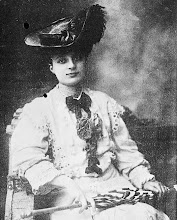This portrait of the esteemed French poet Anna de Noailles
was created in what appears to be charcoal crayon by the Swiss-born artist Paul
Thévenaz (1891-1921) in the early 1900s. The copy seen here is an enlargement
reproduced from its presentation in the August 1916 issue of the American arts
and entertainment magazine Vanity Fair. The portrait, in a highly
angular style tending to an almost cubistic approach and very representative of
the work of Thévenaz, was featured in the
Vanity Fair article by Marie Louise Van Saanen who wrote of the artist’s
theory of ‘Rythmatism’, a concept concerning the relationship between sculpture,
painting, dance, and, more exactly, the music created for the dance. Thévenaz was first a dancer. His talents in
painting and drawing developed simultaneously with his interests in movement and
dancing when he left Geneva and moved to Paris.
Along with the seductively exotic portrait of Noailles, the
magazine article also included three other portraits by Thévenaz, those of Igor Stravinsky, Jean Cocteau,
and Comtesse Etienne de Beaumont, great patron of the avant-garde in art and
music. The artist was an intimate of Cocteau and intensely exchanged ideas with
his friend Stravinsky. He came to the United States after World War One and
died very unexpectedly in New York in 1921 of a ruptured appendix. In America’s
New York City he was known in the circle of creative geniuses huddling there at
the time, such creators as Witter Bynner, Edna St. Vincent Millay and Aaron
Copeland. His focus as his life and art progressed tended toward the decorative
arts, and he was sought after for his interior designs, his portraiture, his
work as a muralist and as a set and costume designer. His commissions in these
aspects were often from the rich and famous and some of his most enduring work
rests in those genres. His Noailles portrait is a fine example of his gifts. Thévenaz owned his own portion of personal
exoticism and was capable, no doubt, of focusing on that characteristic in
others, no matter their gender or the genre of their genius.
The location of the original of the poet’s portrait copied
here is not readily known. A reproduction of it was not included in the
posthumous tribute to the artist and his work privately printed in an edition of
1,000 copies: Paul Thévenaz: a Record of His Life
and Art, Together with an Essay on Style, by the Artist, and Including 107
Reproductions of his Drawings, Paintings & Decorative Work ([New York] : Privately Printed, 1922. The
strié effect in this reproduction is perhaps more the result of
photocopying from a 1916 magazine page in Vanity Fair rather than the artist’s
technique. The gravure process for printing art work in journals was less than
perfect in 1916.
(Provided by the site’s correspondent, Roger Hunt Carroll,
American poet and translator)




